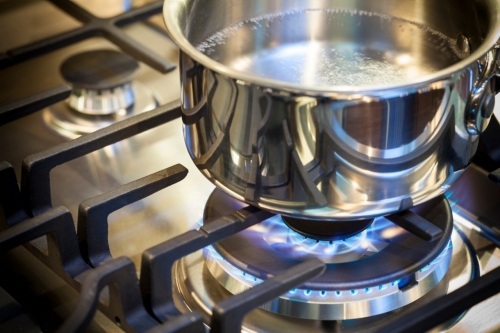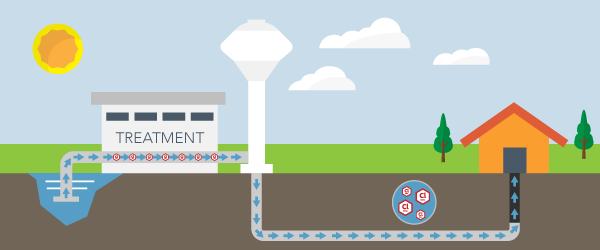Ahh, yes. Chlorine. The official perfume of swimming pools around the world. Beyond its distinctive smell, chlorine also conjures up those warm, eye-reddening reminders from our parents that still ring in our ears from pool days past (“Close your eyes underwater!”). However, while chlorine’s most widely known use may be for disinfecting swimming pools, pool water is not the only type treated with chlorine. Chlorine may very well be in the walls around you as you read this, as it is part of nearly all tap water in the United States. According to the American Chemistry Council, approximately 98% of U.S. public water systems use a form of chlorine disinfection.
This begs the question: what is chlorine, how does it affect your and your family’s health and well-being, and how much is in your tap water?
Let’s clear the air about chlorine and boost your water quality IQ.
FIRST THINGS FIRST. WHAT, EXACTLY, IS CHLORINE?
Chlorine is a chemical element that is a potent oxidizing agent. In its natural form, it is a gas, one that is highly toxic and unstable. Chlorine is also highly concentrated in our oceans and is a vital element with many practical applications — the most common being sodium chloride, also known as table salt. If we shake things a bit more, chlorine is essential to manufacturing PVC pipes, plastics, medicines, seat cushions, and bumpers.
WHY IS CHLORINE ADDED TO DRINKING WATER?
As it relates to your drinking water, chlorine (Cl2) or hypochlorite (an ion composed of chlorine and oxygen), is added to the water at the treatment facility. Water treatment facilities pressurize the gaseous natural state of chlorine to turn it into a liquid. Chorine is added to drinking water because its chemical properties help destroy bacteria, microbes, and pathogens in a water supply. Disinfecting the U.S. water supply drastically reduces the risk of diseases like salmonella, typhoid, cholera, and dysentery. So if chlorine does its job, your water could be free of microorganisms that cause diseases. That’s a big W for chlorine! However, even when chlorine is added, there could be bacteria present in your water when it reaches your home (source: Science X, Date). Common causes include the chlorine breaking down too quickly or microorganisms leaching into the water at some point during the journey from the treatment plant to your home.
THE HARMFUL AESTHETIC EFFECTS OF TOO MUCH CHLORINE.
Beyond taste and odor, the volatile chemical nature of chlorine means it can react and form potentially harmful byproducts. Among the more notable and noticeable of them are those effects on your skin and hair:
- According to the American College of Asthma, Allergy, and Immunology (ACAAI), swimming, bathing, and showering in chlorinated water can cause irritant dermatitis, resulting in itchy, red spots, drier skin, or hives.
- It’s no fun for your follicles, either, because your body naturally produces an oil called “sebum” that coats your skin and hair in a thin protective layer. Chlorinated water can remove part of this protective layer, exposing your hair to potential damage. According to health professionals from Columbia University, without natural oils, your hair can become brittle and cause its natural sheen to diminish.
HOW MUCH CHLORINE IS IN MY WATER?
Good question – and a tough one to answer – as the amount of chlorine in your water is hard to determine as it can vary from district to district. That said, there are some basic guidelines. According to the Centers for Disease Control and Prevention (CDC), the maximum chlorine concentration considered safe for human consumption is 4 milligrams per liter, or 4 parts per million (ppm). The World Health Organization (WHO) estimates that most water treated with chlorine contains the chemical at a concentration between 0.2 and 1 ppm.
HOW TO TEST YOUR WATER FOR CHLORINE.
Suppose you live in a rural area with a modest population and spring water as your primary water source. In that case, your local water supply’s chlorination level may only be tested once a month. It is better to be safe than sorry — don’t assume the chlorine concentration in your water falls between these parameters. If you want to determine the chlorine level in your water, use a Rapid Water Test or request a water quality report from your local municipality to see the chlorine concentration in your area’s drinking water.
Testing takeaway: Remember, once the water reaches your tap, you do no need to consume chlorine. Better still, several methods will allow you to reduce overall chlorine content and bring your water to life.
HOW TO LOWER CHLORINE CONCENTRATION.
If you have determined there is more chlorine in your water than you’d like, there are a few methods of lowering the concentration before you drink it or use it for cooking your dinner. Some are smarter, more efficient, and more effective than others. Let’s start on the “no way, not for me” spectrum.

Good, ol’ fashioned evaporation.
Surely this method won’t be helpful for most modern families who use water often, and for many uses, throughout a day. Nevertheless, chlorine will slowly evaporate from your tap water once it leaves your faucet, so it is an option. Did you know if you let a gallon of water stand for 24 hours, the chlorine will completely evaporate? Use that gallon as a guideline.
Boiling your water.
Boiling water will reduce the amount of chlorine in your tap water but will not remove it entirely. And boiling won’t reduce the amount of chlorine in your shower water at all. Then, there’s the time suck factor. According to the San Francisco Public Utilities Commission (SFPUC), boiling water for 20 minutes will effectively remove chloramine and ammonia from tap water. Their tests were less conclusive regarding removing chlorine, but 20 minutes is 20 minutes.
ENOUGH OF THE IMPRACTICAL. LET’S TALK FILTERS.
Carbon filter technology has come a long way since the ancient Egyptians stored water in charcoal because they discovered the water was fresher and tasted better. This filter alternative is also very common in water purification and filtration products. Makes sense. Carbon filters can reduce the chlorine content in your water and the general taste and odor associated with chlorine and disinfection by-products (DBPs).
- The most common carbon filter products today are activated carbon filters. This type of filter uses granular activated carbon media to reduce many contaminants and unwanted components of your water.
- Less common is a more advanced form of carbon filtration called catalytic activated carbon filtration. Pentair Water Solutions uses these filters in many solutions because catalytic activated carbon has a high capacity for chlorine reduction. Catalytic-activated carbon filters can reduce trihalomethanes (or THMs) and chloramines because the carbon structure changes through different activation and manufacturing processes.
The popular faucet-mounted filtration systems use an activated carbon filter to treat tap water. However, due to their size and the speed at which the water pours out, chlorine reduction in these models might not be as high as you would like.
WHICH CHLORINE WATER FILTERS FILTER CHLORINE BEST?
The ones that offer the combo platter. At Vita Filters, we carry many options, combining activated carbon filters with other filtration technologies to reduce the chlorine and related chemicals in tap and shower water.
Disclaimer: The FDA has not reviewed the information on this website. Products offered for sale herein are not intended to treat, cure, or prevent any disease or health condition. No medical claims are being made or implied. The contaminants mentioned are not necessarily in your water.





Leave a comment